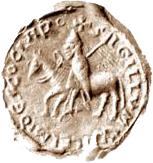Hugh de Saint Clair

A drawing of the chapel at Eslingham. It had stood close to the manor house but was pulled down in 1772.
A photograph of an oast house near the site of the chapel in 1925. It is possible that the cottage on the right was built on the foundations of the chapel. It is notable that the door is in the same position as the door shown in the drawing above.
An engraving of Becket excommunicating Henry’s nobles, one of whom was Hugh de Saint Clair. |
It is unlikely that Hugh was a brother of Hamo and William. Only one charter has Hamo and Hugh testifying together, and that was incorrectly dated long after Hamo had died. Interestingly, a minor distinction was made between the two men in this charter, one having his name spelt as Hamo de Seincler, and the other Hugh de Seint Cler.
Hugh makes his first appearance when John the Second, bishop of Rochester, dedicated a chapel in Hugh’s manor of Eslingham in the parish of Frindsbury, Kent, and confirmed privileges to him and his family. This was between 1137 and 1144, by which time Hugh must already have had children, making him 32 years of age if he was born c.1105.
A descendant, William de Saint Clere, was sheriff of Hertfordshire and Essex in 1278 and held Great and Little Okeley in Kent, close to Eslingham, and East Tilbury in Essex, just across the Thames. The connection between the north and south sides of the Thames is deeply embedded in the river’s history here. In 1086, Higham in Kent had pasture for 200 sheep in Essex and a medieval ferry is known to have existed, so holding lands on both sides of the Thames was not uncommon.
Hugh de Saint Clere attended Henry II’s court, and must often have been absent from his manor. His name is linked to one of the most infamous events in British history. Hugh is recorded as holding land belonging to the Archbishop of Canterbury at Niwenden in Kent and Tierring in Sussex between 1165 and 1172, and for this he was excommunicated by the pope in 1166, and again in 1169. Thomas Becket was murdered by four of Henry’s household knights in Canterbury in 1170.
Because of Hugh’s close association with Henry’s court, his sons must have been well aware of the visit of William “the Lion”, king of Scotland, after his release in Normandy in 1174. This provided the youngest, who had the most to gain, an ideal opportunity to meet the Scottish king and take up his offer of land and riches in return for their support. This, according to Scalacronica, was the year when the Saint Clairs arrived in Scotland. There they were given land in Lothian by William de Morville, hereditary constable of Scotland. This was a family the Saint Clairs knew well, and not just because one of their number was present at the death of Becket.
After 1169, Hugh de Saint Clere is not heard of again, suggesting he had died, by then aged about 65. A son, Thomas de Saint Clere, was witnessing charters in Kent from 1180, and he probably inherited his father’s estates. John de Saint Clere, who was witnessing charters between 1200 and 1261 in both Kent and Essex, may well have been Thomas’s son. Another John was witnessing charters between 1310 and 1336 in at least five southern counties, and was probably the first John’s son.
England to Scotland
Unfortunately, there is too little documentary evidence to prove beyond all doubt that Hugh was a brother of Hamo and William, or that several of his sons or grandsons accompanied king William back to Scotland. But there is circumstantial support for such a theory. Hugh was of the same generation as Hamo and William; after Hamo’s son Hubert died in 1155, no Saint Clair other than Hugh is known to have held land in Kent or Essex at that time; even if he was not a great tenant-in-chief, Hugh’s role as one of the king’s familiares must have given him and his family a high status, high enough to act on behalf of the king in the Becket affair; because of Hugh’s attendance at Henry’s court, his family would have known that the king of Scotland would be passing through London, giving them an ideal opportunity to meet him; and finally, pre-existing relationships between the Saint Clair and Morville families in England would have made it easier for any of the younger Saint Clairs who joined king William to establish themselves in Scotland.





